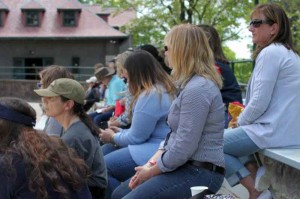

“The United States is the only country where veterinarians give hock injections,” Heuschmann stated. “There is no need. Sixty percent of lameness problems cannot be diagnosed; however, if you understand the horse, balance and seat, lameness problems can be fixed in a matter of days without unnecessary steroids.”
Heuschmann discussed the importance of the rider’s seat, and how it is the key to classical training. Each rider must know how to have a light seat; it is the most important because this is where all of the connection and feeling happens.
The information from the lecture proved pertinent as five riders from the first group approached the USET Foundation Arena for the mounted session. There was not a jump in sight as Brittni Raflowitz, Jacob Pope, Maggie McAlary, Sloane Coles, and Scott Lico entered the ring with their mounts. Morris and Dr. Heuschmann soon arrived and immediately put their teachings to practice.
Using half of the ring, Morris began the clinic in normal fashion, adjusting positioning and equipment. Riders worked on giving and taking, using minimal use of their hands while focusing on their legs and seat.

“I don’t like a chair seat,” Morris’ booming voice could be heard throughout the arena. “Make sure that you are using a light seat and are positioned forward.”
As they loosened up their mounts and continued around the ring, Dr. Heuschmann commented on how to make them the driver and not the passenger. He focused on not allowing the horse to get above the hand, transitioning from posting trot to sitting trot using the horse’s natural rhythm.
Heuschmann instructed Pope to post on the opposite diagonal, aligning the right hand and the right front. The exercise maintained the purpose of working to sensitize while not desensitizing their mounts, always keeping the horses in front of the leg, and working on longitudinal schooling.
“I always put these three things together on the flat: longitudinal, lateral one track and lateral two schooling,” Morris said. “Longitudinal schooling helps us to work with going forward, backward, and using transitions. The latitudinal schooling incorporates serpentines and circling. I incorporate all three of these to loosen the horse and prepare them to jump. It opens them up to stretch, you must know when to go with the stretch.”
Morris worked closely with Lico to better help his grey mare to respond to leg contact. His techniques opened her up to a more progressive training, and she began to accept and allow Lico to play with the length of her neck. By the end of the session she was accepting the leg, falling into rhythm and correcting her mouth to become suppler.

The riders finished the session out by picking up the counter canter to work on balance. With tomorrow’s jumping session quickly approaching, today’s flat work prepared each of the riders for what they are to face tomorrow. “Jumping is a reflection of the walk, trot, and canter. It is the horse’s natural ability. If the horse is supple and loose, then they will use their natural ability to jump it as best they can,” Morris stated.
The second group of riders, Alec Bozorgi, Karina Busch, Katie Cox, Christi Israel and Savannah Talcott, delved deep into the biomechanics of the horse and the proper positioning to allow for a supple horse.
Heuschmann stood center ring as he commented on leg positioning and hand placement. He advocated keeping hands aligned with the horses’ mouths, working toward a round poll and softness in their movements.
“The hand is made in your seat,” Heuschmann relayed. “One of the most important things you can learn is to keep the hand in balance. Once you are balanced you can relax the shoulders, and in turn, that allows you to work the horse into a longer frame.”
Heuschmann used many of the techniques he had discussed earlier in the day to provide examples for the riders. He utilized the “back-up” to help bring the horses in closer contact with their riders. After a few steps back the horses were responding with a brand new reaction to the aids, lengthening their necks and becoming suppler.
As the group sessions came to a close Morris picked up his measuring tape and walked into the arena with the 10 students following closely behind. Together they built the course for tomorrow afternoon’s gymnastics session.

“The Gladstone Program is not a horse show, it is an educational program. Everyone is going to ‘school’ and learning from veterinarians, sports psychologists, stabling management. It is a different experience, but the overall principle is horsemanship,” Morris concluded. “The participants in the
Gladstone Program will have the opportunity to sit with me and design a program, and learn the most important parts of horsemanship as horse trainers.”
Day two of the clinic will commence at tomorrow morning with flat work mounted sessions at 8 a.m. and 9:30 a.m. and later in the afternoon riders will tackle the recently set gymnastics at 2:30 p.m. and 4:15 p.m. All sessions are open to the public for auditing.
The United States Equestrian Team Foundation (www.uset.org) is the non-profit organization that supports the competition, training, coaching, travel and educational needs of America’s elite and developing international, high-performance horses and athletes in partnership with the United States Equestrian Federation.
For more information on the USET Foundation, please call (908) 234-1251, or visit USET ONLINE at www.uset.org.



